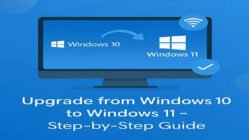Transfer FSMO Roles in Active Directory (GUI & NTDSUTIL)
Introduction
In the previous lesson (Day-34 FSMO Roles Part-1), we explored what FSMO roles are, their five types, and why they are crucial in Active Directory. If you missed that session, check it out here on YouTube or read the blog post on it4u.in.

In Part-2, we move beyond theory into practical administration. You’ll learn how to:
- Transfer FSMO roles when your Primary Domain Controller (PDC) is running.
- Seize FSMO roles when your PDC is down permanently.
- Use both GUI and NTDSUTIL command-line approaches.
- Apply best practices for role placement in real-world enterprise setups.
This is one of the most important topics for MCSA learners, IT administrators, and anyone preparing for Active Directory interviews.
Why FSMO Role Transfer Matters
Active Directory depends on FSMO roles for smooth operation.
If your PDC fails or requires maintenance:
- Without proper role transfer: authentication issues, login failures, Group Policy problems, and trust errors may occur.
- With proper transfer: your Additional Domain Controller (ADC) can take over seamlessly, preventing downtime.
This is why every sysadmin must know when and how to transfer or seize FSMO roles.
Two Scenarios for FSMO Transfer
1. When the PDC is Available

Sometimes you intentionally want to move roles:
- During server upgrades or patching.
- For load balancing (distributing FSMO roles across multiple servers).
- For planned maintenance where the PDC will be offline temporarily.
👉 In this case, you use a normal transfer (graceful handover).
2. When the PDC is Not Available

If the PDC is permanently down (hardware failure, crash, or network loss), normal transfer won’t work.
- Here, you must seize FSMO roles forcefully using NTDSUTIL.
- Once seized, the old PDC must not return to production unless fully rebuilt, to avoid conflicts.
👉 This is often called a disaster recovery scenario.
Checking FSMO Role Holders
Before you transfer roles, always verify which server currently owns them.
Command Prompt Method:
netdom query fsmoOutput will show:
- Schema Master
- Domain Naming Master
- RID Master
- PDC Emulator
- Infrastructure Master
👉 This step is crucial to confirm current role distribution.
Transferring FSMO Roles (When PDC is Available)
GUI Method (Beginner-Friendly)
- RID, PDC Emulator, Infrastructure Master → In Active Directory Users and Computers, right-click the domain → Operations Masters.
- Domain Naming Master → In Active Directory Domains and Trusts, right-click root node → Operations Master.
- Schema Master → In Active Directory Schema snap-in (enable using
regsvr32 schmmgmt.dll).
Click Change to transfer the role to your ADC.
Command-Line Method (NTDSUTIL)
- Open CMD as Administrator.
- Run:
ntdsutil
roles
connections
connect to server <ADC_Name>
quit
transfer schema master
transfer naming master
transfer rid master
transfer pdc
transfer infrastructure master- Confirm success:
netdom query fsmo👉 This method is faster if you are comfortable with CLI.
Seizing FSMO Roles (When PDC is Down)
If your PDC is gone permanently:
ntdsutil
roles
connections
connect to server <ADC_Name>
quit
seize schema master
seize naming master
seize rid master
seize pdc
seize infrastructure master⚠️ Warning: Once seized, do not bring back the failed PDC unless fully rebuilt.
This ensures the ADC can act as the new PDC without conflicts.
Best Practices for FSMO Placement
- Distribute roles across servers: Don’t keep all 5 FSMO roles on a single DC in large environments.
- Backup Domain Controllers: Always maintain at least one ADC ready to take over.
- Time Sync: Ensure the PDC Emulator syncs with an external reliable time source.
- Document Role Holders: Keep a record of which DC holds which role, for quick recovery in outages.
- Test Role Transfer: Practice in a lab before doing it in production.
GUI vs NTDSUTIL: Pros & Cons
| Method | Pros | Cons |
|---|---|---|
| GUI | Easy to use, beginner-friendly | Requires PDC availability |
| NTDSUTIL | Works even in disasters, faster for admins | Less beginner-friendly, higher risk of errors |
👉 For planned maintenance, use GUI.
👉 For emergencies, NTDSUTIL is essential.
Common Interview Questions
- How many FSMO roles exist, and which are forest-wide?
→ 5 roles; Schema Master & Domain Naming Master are forest-wide. - Difference between transfer and seize?
→ Transfer = graceful handover, Seize = forceful takeover when PDC is unavailable. - Which FSMO role handles time synchronization?
→ PDC Emulator. - Can FSMO roles be split across servers?
→ Yes, for redundancy. - What happens if RID Master is down for a long time?
→ New objects cannot be created once RID pool runs out.
Conclusion
In this part, we learned how to transfer FSMO roles when the PDC is available and how to seize them when it’s not. We also explored GUI vs NTDSUTIL approaches, best practices, and interview questions.
By practicing these steps, you’ll gain the confidence to handle FSMO transfers in both normal maintenance and disaster recovery scenarios.
👉 Have you ever had to seize FSMO roles in a real-world environment? Share your story in the comments below!
💡 Don’t forget to subscribe to IT4U for more tutorials.
❓ Frequently Asked Questions (FAQ)
1. How do I check current FSMO role holders?
Run netdom query fsmo to see which DC holds each role.
2. What is the difference between transferring and seizing FSMO roles?
- Transfer = graceful handover when the PDC is online.
- Seize = emergency takeover when the PDC is offline permanently.
3. Which FSMO roles are forest-wide?
Schema Master and Domain Naming Master.
4. What happens if FSMO roles are not transferred after a PDC failure?
AD functions such as RID allocation, time sync, password updates, and domain naming may fail.
5. Can FSMO roles be spread across multiple servers?
Yes, distributing roles improves fault tolerance.
6. Why is the PDC Emulator role important?
It handles time synchronization, password changes, and Group Policy updates.
7. Which method is best for beginners?
GUI method is easier, but NTDSUTIL is essential for emergencies.









Add comment